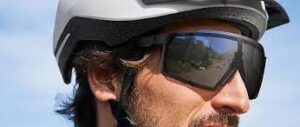Long-distance cycling challenges the eyes as much as the body. Constant sunlight, glare, and wind can quickly lead to visual fatigue, making it harder to stay focused and safe. Cycling sunglasses are designed to solve this problem by blocking harmful rays, reducing glare, and providing clear, comfortable vision. In the following sections, we explore how they help riders reduce eye strain during long rides.
1.Why Eye Strain Is a Serious Issue for Cyclists
- The impact of sunlight and glare
During rides that last several hours, the eyes are under constant attack from sunlight, reflective surfaces, and sudden changes in brightness. Without protection, eye strain can increase by more than 30% after four hours of exposure, directly reducing concentration and comfort. Professional cycling events often last 5–7 hours, which means that the eyes are working under strain for longer than a typical workday in front of a screen. This continuous demand makes protective eyewear not just optional but essential.
- The role of environmental factors
Dust, wind, and dry air also contribute to discomfort. Riders often squint subconsciously to shield their eyes, which forces the muscles to remain tense. Over long distances, this repetitive strain leads to headaches and reduced reaction times. On descents where speeds can exceed 70 km/h, even small delays in visual response can pose safety risks. By acting as a physical barrier, sunglasses reduce the number of involuntary adjustments the eyes need to make, helping cyclists maintain sharper focus and quicker reaction times.

2.Advanced Lens Technology for Better Visual Comfort
- UV protection and glare reduction
High-quality lenses are engineered to block 99% of UVA and UVB rays, preventing short-term irritation and long-term risks such as cataracts. Polarized lenses cut glare by up to 90%, keeping vision stable even when sunlight bounces off water, car windows, or asphalt. Scientific measurements show that glare forces the pupil to constrict by as much as 40% more than usual, accelerating fatigue. By minimizing glare, riders save visual energy that can instead be directed toward maintaining awareness of traffic, road hazards, and navigation.
- Photochromic and anti-fog solutions
On routes with shifting light, photochromic lenses adapt automatically within 15–30 seconds, preventing constant squinting. This reduces the workload of the ciliary muscles, which otherwise contract and relax continuously to adjust to brightness changes. Anti-fog coatings and ventilated designs reduce lens condensation by as much as 70%, ensuring clear vision in humid or high-intensity conditions.
This is particularly valuable during climbs, where sweat and heavy breathing create microclimates behind the lens. A consistently clear field of vision helps reduce eye stress and lowers the risk of accidents caused by impaired sight.
3.The Science Behind Eye Fatigue in Cycling
- Muscle strain and focus adjustment
When cycling, the ciliary muscles inside the eyes are constantly adjusting to changes in light and distance. Over long periods, this repetitive contraction and relaxation leads to micro-fatigue, similar to how leg muscles tire after constant pedaling. Without sunglasses to stabilize incoming light, the rate of muscular strain can increase by 40%, accelerating the onset of visual discomfort.
- Pupil dilation and energy consumption
Sudden transitions from sunlight to shade trigger rapid pupil dilation. Research indicates that frequent dilation can increase ocular energy consumption by 15%, leaving riders feeling mentally drained sooner. Sunglasses that balance brightness reduce these fluctuations, conserving energy for focus and decision-making during long-distance rides.
4.Emerging Technologies in Cycling Sunglasses
- Smart lenses and augmented reality
The latest generation of eyewear integrates AR displays, projecting speed, distance, or navigation directly onto the lens. This eliminates the need to glance down at a cycle computer, reducing refocusing demands by 200–300 times per ride, and indirectly lowering eye strain.
- Blue light filtering and digital protection
With more cyclists using GPS devices and smartphones during rides, exposure to artificial blue light is rising. Lenses with blue-light filtering technology reduce retinal stress, preventing cumulative fatigue over multi-hour rides. This technology, once limited to office glasses, is now entering high-performance cycling sunglasses as a standard feature.
5.Conclusion
Cycling sunglasses are more than just protective gear; they are essential equipment for endurance riders. Advanced lenses, ergonomic designs, and modern technologies reduce strain, improve clarity, and ensure long-term comfort. They protect against UV rays, cut glare, adapt to changing light, and now even integrate digital tools for enhanced riding performance.
By choosing certified products from trusted cycling sunglasses supplier and combining them with smart riding habits, cyclists can protect their vision and extend their performance capacity. With the right eyewear, every kilometer becomes safer, clearer, and more enjoyable. For both recreational riders and professionals, investing in high-quality cycling sunglasses is an investment in both safety and endurance.
